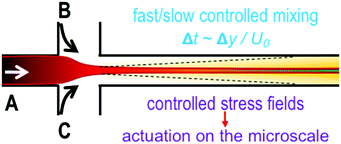SAXS on a chip: from dynamics of phase transitions to alignment phenomena at interfaces studied with microfluidic devices
Abstract
The field of microfluidics offers attractive possibilities to perform novel experiments that are difficult (or even impossible) to perform using conventional bulk and surface-based methods. Such attractiveness comes from several important aspects inherent to these miniaturized devices. First, the flow of fluids under submillimeter confinement typically leads to a drop of inertial forces, meaning that turbulence is practically suppressed. This leads to predictable and controllable flow profiles, along with well-defined chemical gradients and stress fields that can be used for controlled mixing and actuation on the micro and nanoscale. Secondly, intricate microfluidic device designs can be fabricated using cleanroom standard procedures. Such intricate geometries can take diverse forms, designed by researchers to perform complex tasks, that require exquisite control of flow of several components and gradients, or to mimic real world examples, facilitating the establishment of more realistic models. Thirdly, microfluidic devices are usually compatible with in situ or integrated characterization methods that allow constant real-time monitoring of the processes occurring inside the microchannels. This is very different from typical bulk-based methods, where usually one can only observe the final result, or otherwise, take quick snapshots of the evolving process or take aliquots to be analyzed separately. Altogether, these characteristics inherent to microfluidic devices provide researchers with a set of tools that allow not only exquisite control and manipulation of materials at the micro and nanoscale, but also observation of these effects. In this review, we will focus on the use and prospects of combining microfluidic devices with in situ small-angle X-ray scattering (and related techniques such as small-angle neutron scattering and X-ray photon correlation spectroscopy), and their enormous potential for physical–chemical research, mainly in self-assembly and phase-transitions, and surface characterization.

- This article is part of the themed collections: PCCP Perspectives, 2017 PCCP HOT Articles and Surface chemistry and interface science


 Please wait while we load your content...
Please wait while we load your content...